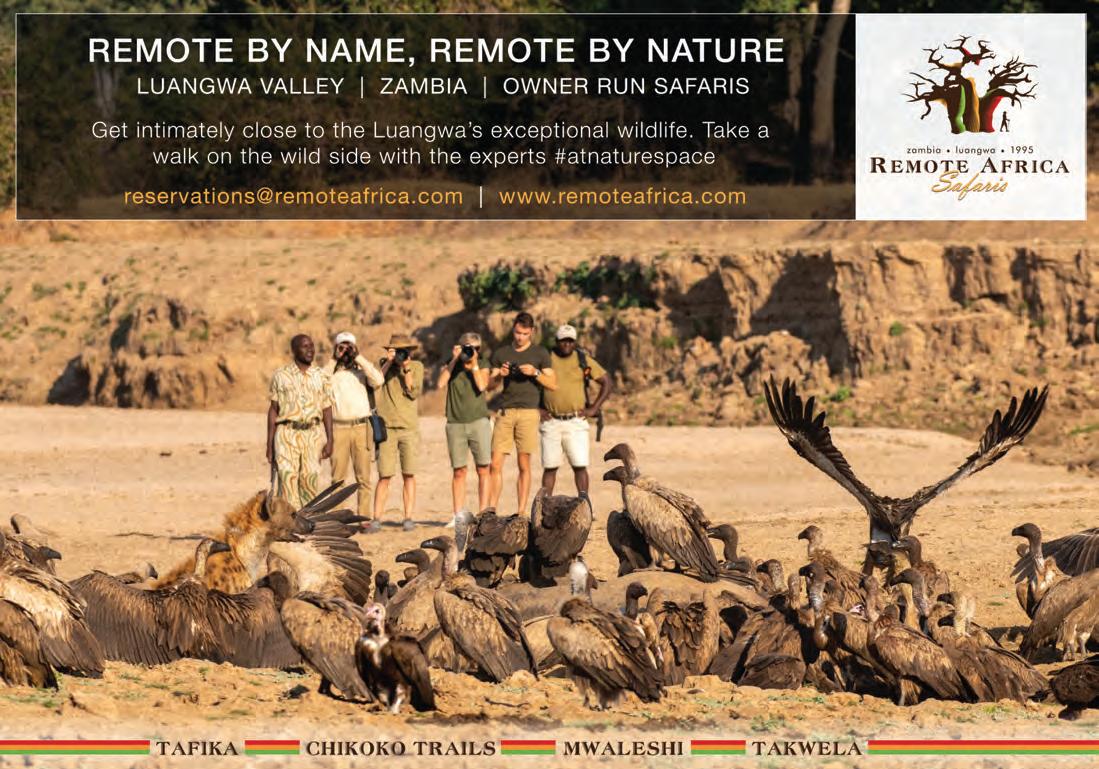
5 minute read
A Walk on the Wildside
A Walk ON THE WILD SIDE
[WRITER: Stephanie Naidoo ] [ PHOTO: Robin Pope Safaris ]
Advertisement
For those wanting to get closer to nature, a walking safari has got to be one of the most authentic and exhilarating ways to appreciate the African wilderness. There is nothing quite so liberating as exploring on foot, not being confined to a vehicle and thus able to go off the beaten track.

How did walking safaris come about?
South Luangwa National Park in Zambia is the home of the walking safari, however African safaris had to evolve quite a bit to get to where they are today. Norman Carr is widely recognized as one of the early pioneers of the photographic safari experience in Zambia and particularly for spearheading the concept of walking safaris. Prior to him, a typical safari to Africa was for trophy hunting only but through his love for wildlife he managed to shift the paradigm and promoted the idea of people coming on safari purely to look and observe the wildlife and the surroundings. Today many of the original photographic camps that pioneered walking safaris are still accessible, like Nsefu Camp which was set up in the 1950’s and has gained notable popularity within the safari world! But what makes South Luangwa National Park so special? lives up to both these accolades and more. The South Luangwa National Park is 9,050 square kilometre; with the river, its tributaries and the riverine strips being the focus of the wildlife viewing. There are diverse habitats, from huge ox bow lagoons of varying stages of maturity, woodlands, ebony groves, grassland and thickets, that host a great variety of wildlife.
Tracking Wildlife
Aside from taking in the sights and sounds of the bushveld, walking safaris are to a larger extent focused on tracking wildlife, such as cats as well as the larger game including elephants, kudu, elands and giraffe.
You are forced to use all your senses, giving you a chance to touch, smell, feel and hear everything around you, analyzing different animal tracks, dung, broken foliage nearby with the help of the experienced guide. Although tracking requires patience and perseverance it is so very rewarding sensory and social experience! Jason Alfonsi has been
leading walking safaris for over 20 years in the South Luangwa National Park. He had the following to say:
“As a guide you cannot push or force experiences. Everything has to fall into place naturally. Giving the animals as much time as they need to decide on their course of action and not rushing them usually leads to more interesting encounters. These encounters can bring wonderful experiences and we as guides are highly trained to safely appreciate them when we are in the right place at the right time.”
Aside from the big game, walking allows you to experience the little things which are completely missed when in a vehicle, from investigating ancient termite mounds or interesting bird’s nests to finding the rather shy sand lions.
Walking Experiences in South Luangwa
Several of the big safari operators in the South Luangwa National Park offer Mobile Safaris whereby the focus is strictly walking and you change camp locations several times during the trip. They are usually about 5-7days long and guests will walk about 10 kilometre per day.
A typical day on a walking safari will start off just before sunrise. The air is cool and the bush is still. After a light breakfast the walk begins and depending on what you find, you can end up deep within the bush or even ankle deep in a river. There is never a set plan of what route you will take, making it that more exciting.
The accommodation is usually comfortable meru style tents and the food first class, despite the lack of proper stoves and electricity. While guests are out on their walk, the camp will be broken down and moved to the next spot, with everything perfectly set up and ready for when the guests get there. After the morning walk is done, a hearty brunch followed by a much needed siesta before guests are back out again in time to enjoy yet another beautiful sunset in Africa. Once back in camp, there is nothing like winding down with a hot shower under the stars, which is all possible on these mobile walking safaris, and are such a treat.




These mobile walking safaris are the perfect way to connect with nature and completely disconnect from the outside world, which does wonders for the mind, body and soul. For those who find a mobile walking safari rather daunting, there is also the opportunity to do short walks from the camp or lodge they are staying at in South Luangwa thus still getting to experience the magic of being on foot in the wilderness but without having to spend 5-7 days in the remote parts of the park.
Many who have experienced a walking safari in Zambia have compared them to a bygone era, and likened them to what David Livingstone’s expedition in Africa must have felt like.
The future of walking safaris
As the travel industry continues to adapt and adjust to the ‘new normal’ in the wake of the covid-19 pandemic, the need for people to reconnect with nature has never been more apparent. Holidays such as walking safaris should be on everyone’s radar as the lack of crowds and open air activities in the vast wilderness make for a safer and more responsible experience.
We also have to acknowledge the shift in peoples need to travel with intent and purpose. The demand for more immersive and experiential trips has increased within the last decade and walking safaris ticks all those boxes.
Walking safaris are a treat for all the senses and everyone should experience walking in the wild at least once in their lifetime!












